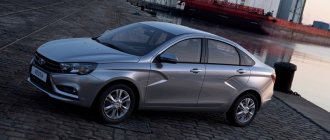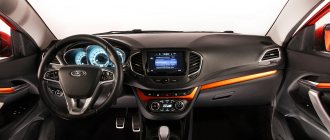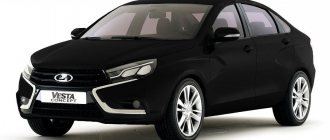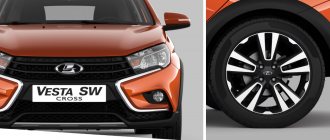Recently, two similar new products from the automotive industry quickly burst into Russia. One of them is domestically produced, and the second is Korean. What to choose - Lada vesta sw cross or Kia rio x line? Experts immediately made a comparison and noted that these models are direct competitors in many respects.
Car enthusiasts who dream of a passenger car with a fairly high clearance will now have to compare the Cross with the Rio car. Lada vesta sw cross is a new class B station wagon from AVTOVAZ, and Kia rio x line has become an updated version of the legendary Rio hatchback. Our review includes a comparison of the Lada Vesta SV Cross and the Kia Rio X Line. Read the article and figure out which car is right for you and your family - we hope this comparison will answer all your questions.
Body paintwork and metal thickness
Paintwork is the most important element of external protection for a car. The thickness of the paintwork, measured in neurons, is an indicator of quality. In different models of foreign cars, the spread of coating thickness ranges from 80 to 180 microns, and it varies in different parts of the car.
Lada vesta sw cross and the kia rio x line model have paintwork indicators of 120–135 and 138–173 microns. Russian new product Cross, available in 10 shades. For example, the spectacular bright scarlet metallic Mars. In the near future, the manufacturer intends to expand the color line.
The Korean Rio comes in 9 paint options, and the color scheme is bolder and includes, in addition to neutrals, Marina Blue and Sunset Orange. The Lada Vesta Cross, like the Kia Rio x Line in the new body, deserves all sorts of praise for the quality of the paintwork. Even places that are difficult from the point of view of the craftsmen - arches, internal compartments, bevels of doorways - are painted neatly and evenly. The relief of the paintwork (which is usually called shagreen), then it differs on plastic and metal parts. This is explained by painting technology.
Exterior and interior
Vesta SW Cross, according to automotive experts and publications, is the most beautiful car created by AvtoVAZ. Successful design solutions taken from the front-wheel drive sedan are effectively implemented in the new body.
The car received a bright appearance, a neat plastic body kit, and stylish wheels. As a result, the Lada car is superior to the nice, but more modest “Korean”.
The loser is the front part of the new Rio, which smacks of bad taste and “Chinese”, despite several original solutions. But the rest of the car was a great success for the Kia design department. The rear optics and dual exhaust pipes deserve special praise.
Conclusion. Vesta looks nicer compared to the Rio hatchback with an off-road body kit and other all-terrain station wagons. The new AvtoVAZ car looks better in the special “Mars” color scheme.
Chassis and ground clearance
In Russian road conditions, cross-country ability plays a big role. Car enthusiasts compared the ground clearance of the Russian Lada and that of the Korean. The ground clearance of the cars is 203 and 170 mm. The brainchild of AVTOVAZ will easily overcome any curb when parking.
The ground clearance of a Korean car (170 mm) is not suitable even for minor off-road conditions - the ground clearance is not enough, and the front overhang is long. While tests of Vesta show: overcoming uneven ground at a speed of 40-50 km/h, the suspension cannot be broken. To be fair, we note that it still won’t cope with deep potholes; suspension repairs after a race on roads damaged by winter frosts will be inevitable.
As for the design features, both cars have a comfortable MacPherson strut suspension at the front, and an independent rear suspension with a torsion beam. The Russian manufacturer equipped the Cross with front disc brakes and installed drums at the rear. The Rio comes with the same set as standard, but for an additional fee you can buy a top-end version of the Korean with rear disc brakes.
Interior features
Steve Martin, chief designer of AVTOVAZ, has developed a stylish design for the Vesta Cross, which many like even more than the design of its Korean competitor. But in comparison with the comfort of the interior, the Lada Vesta Cross is inferior to the Kia Rio X Line: the lumbar support of the back of the front seat seems to be a good find, but the lower cushion is made too short.
Compared to Rio, the seat is more rigid and uncomfortable. And Lada passengers in the second row will be much more comfortable thanks to the large gap between the back of the seat and the knees. A characteristic feature of both models - a sloping ceiling - looks stylish, but a tall passenger will prop it up with his head.
The quality of the interior and its equipment is inferior to Vesta: a rather harsh steering wheel, stiff window lifter buttons. Data from the speedometer scale is difficult to read. The steering wheel has pleased car enthusiasts - it is conveniently adjustable in terms of inclination and reach. Both models have curtain airbags on top trim levels.
Vesta offers seat upholstery in black + gray and black + orange. Kia has a color combination: black + red. The Korean's interior materials are better in appearance than those of the Russian station wagon.
About the interior
The build quality of the Rio's interior is higher than that of the Vesta, although the Togliatti automaker offers a solid and neat interior with bright decorative inserts, a comfortable steering wheel, and a competent location of the main controls.
However, Kia's rich experience in the production of budget cars is telling. In the “Korean”, literally every little detail, regulator and switch, is thought out, although there is no point in idealizing the 5-door hatchback. This is a high-quality, inexpensive salon that will not allow you to feel discomfort, but will not give you pleasure either.
In the most expensive version of the South Korean hatchback, leather seat trim is available, while in the top trim levels of the Russian car only combined (leather + fabric) is offered.
Conclusion. The Rio X-Line has a higher quality interior compared to the Vesta SW Cross. The domestic car looks decent compared to its foreign competitor thanks to the efforts of the designers, who decorated the interior with decorative inserts and overlays on the front panel. However, the more expensive configurations of the “Korean” look richer.
Warranty
Sales of the new Rio X Line began in 17, and should grow in 18. The warranty for a new car is 100,000 km or 3 years. But the warranty period for individual structural units and parts will be shorter (for example, for batteries and shock absorbers - 2 years).
But the Korean manufacturer gives a guarantee for Rio of 150,000 km, or 5 years. A scheduled inspection is required every 15,000 km, but this interval may be reduced if the car is used very intensively, for example, as a taxi. Warranty service, according to reviews from car owners, is better provided by a Korean company.
LADA Vesta SW Cross vs KIA Rio X-line: which will be cheaper to maintain?
Whatever one may say, LADA Vesta SW Cross and KIA Rio X-line can become bestsellers in our market. We decided to pit them against each other in our traditional column comparing the cost of service. Which one is cheaper when reaching a virtual mileage of 120,000 km? Is it worth staying at the dealer for service to maintain the warranty? What is there in the guarantee that could keep the client from using the official service? We will try to answer these questions in order to facilitate the process of choosing a new car.
One of the “test subjects” is a slightly raised station wagon, the second is a hatchback. In general, these are two practical cars with an “off-road” appearance for reasonable money. You can read about their consumer qualities here and here.
Features of the LADA Vesta SW Cross warranty
The warranty period for Vesta SW Cross is set at 5 years or 100,000 km, whichever comes first. The warranty period includes the main and additional terms.
The main warranty period is established by the manufacturer and is 3 years or 100,000 km. The additional warranty period is set by the seller and is 2 years or 100,000 km. Paintwork warranty - 36 months or 100,000 km. The seller guarantees the absence of through corrosion - the period of this guarantee is 6 years from the date of transfer of the car to the buyer.
The individual components listed below are warranted as follows:
- shock absorbers, rolling bearings, exhaust gas system elements, including catalytic converters, oxygen sensors - 12 months or 35,000 km, whichever comes first;
- batteries - 24 months;
- tips, struts, bushings for steering rods and anti-roll bars, ball joints, silent blocks, rubber-metal joints, supports and compression stroke buffers for struts, suspension arms and power units, drive wheel drives with protective covers, rubber hoses and pipes, headlights, switches , switches and control devices for components (control modules for lighting, power windows, heated seats), manual brake cables, flexible hoses for front and rear brakes, water and electric fuel pumps, expansion tank and its components - for front-wheel drive vehicles 36 months or 50,000 km, for all-wheel drive and rear-wheel drive vehicles 24 months or 35,000 km.
Warranty obligations are no longer valid if the owner has made changes to the software, factory settings, parameters of electronic control units, changed mileage data in the odometer readings or in other devices provided by the manufacturer, as well as when installing gas equipment.
The warranty does not cover corrosion processes of fasteners, suspension parts, transmission parts, engine parts, body trim elements, parts that are not body parts (wheel rims, exhaust system parts, etc.). It also does not apply to consumable automotive components, including fuels and lubricants and operating fluids of all vehicle systems, wiper blades, fuses, filters, lamps, spark plugs, drive belts and related rollers, tires, brake pads, discs and drums. In the event of a manufacturing defect or material defect, these parts will be replaced under warranty.
The warranty does not cover minor noises (clicks, squeaks, vibrations) that appear as a result of operation and are a design feature of the car, which do not affect the safety, characteristics and performance of the car or its elements, as well as minor (not leading to a noticeable decrease in their level) seepage (leakage) liquids through gaskets and seals, imperfections in finishing elements, paint and varnish and galvanic coatings that are indistinguishable without the use of special diagnostic methods. Moisture condensation on the internal surfaces of external lighting fixtures, in closed cavities of the car, and on glass inside the passenger compartment is also not a warranty case.
Malfunctions and damage resulting from exposure to chemically active substances that pollute the environment, including those used to prevent freezing of road surfaces, substances of plant origin and animal waste products are not covered by the warranty.
Features of the KIA Rio X-line warranty
The warranty period is 5 years with a mileage limit of 150,000 km and applies to all units and components of the vehicle, except for those listed below:
- The warranty for the battery and air conditioner refrigerant refill is 12 months without mileage limitation;
- the paintwork warranty is 3 years with a mileage limit of 150,000 km;
- against through body corrosion there is a 10-year warranty without mileage limitation for all models, with the exception of the KIA Mohave (72 months for the KIA Mohave).
As you can see, in terms of warranty, KIA benefits by limiting the mileage to 150,000 km, rather than 100,000. Also, the warranty against through corrosion is 10 years, not 6, as in the case of LADA.
Parts subject to normal wear and tear, such as seat trim, steering wheel, pedal pads and other interior and exterior elements, are warranted for 1 year or 15,000 km.
The warranty period for suspension parts subject to natural wear (ball joints, silent blocks, shock absorbers, springs, bearings, etc.) is 5 years or 100,000 km. The warranty period for the catalyst is 35 months or 100,000 km.
The warranty does not cover damage or corrosion of the surface caused by environmental factors: acid rain, deposition of substances from the air (chemicals, plant sap, etc.), waste products of birds and animals, hail, storms, floods and other uncontrolled phenomena, and also salts and sand-salt mixtures. Corrosion caused by insufficient car care is also not covered under warranty.
In case of failure of consumable parts (discs, pads, drums, clutch disc, wiper blades, drive belts, spark plugs, light bulbs, filters, oils, etc.), the warranty period for them is 12 months or 15,000 km.
It is indicated that normal operating consumption of technical fluids is allowed. For example, the permissible oil consumption is 600 g/1000 km for four-cylinder engines.
Cost of body parts
No one is insured against road accidents. If there is no CASCO insurance, the person responsible for the accident will pay for the repair of the damage out of his own pocket. The cars have just appeared on the market, there are no used parts for them on bamper.by yet, so you will most likely have to look for spare parts only at the dealer. Although you can already find something for the Vesta sedan among used cars. So, how much do basic body parts cost?
| Detail | Cost, rub. | |
| LADA Vesta SW Cross | KIA Rio X-line | |
| Front door | 650 | 1048 |
| Rear door | 650 | 1202 |
| trunk lid | 390 | 1230 |
| headlight | 479 | 622 |
| Front bumper | 189 | 355 |
| Rear bumper | 189 | 369 |
| Side mirror | 185 | 398 |
| Hood | 390 | 1302 |
| Heated windshield | 415 | 477 |
Shock! Only the price of a heated Rio X-line windshield came close to the cost of Vesta SW Cross glass. Otherwise the prices are very different. It feels like the Rio X-line trunk lid is made of pure gold, because its cost is 1,230 rubles. It is more than three times more expensive than a similar Vesta SW Cross part. The cost of KIA body parts is very high. This car definitely needs to be covered by CASCO until used parts appear on the market. Although LADA is also not particularly cheap to beat.
Scheduled maintenance of LADA Vesta SW Cross and KIA Rio X-line
Failure to comply with maintenance deadlines may result in cancellation of the warranty, which is stipulated in the contracts of all dealers. The maintenance interval for these vehicles is 15,000 km or 12 months, whichever comes first.
| Materials | Cost, rub. | |
| LADA Vesta SW Cross | KIA Rio X-line | |
| Motor oil | 48.4/4.4 l (11/1 l) | 100/3.6 l (27.96/1 l) |
| Oil filter | 7,50 | 17,52 |
| Fuel filter | — | 86,40 |
| Air filter | 22,50 | 51,96 |
| Cabin filter | 19,90 | 55,56 |
| Working hour | 50 | 65,40 |
Let's try to calculate how much it will cost to maintain a car in technically sound condition as part of dealer service up to a mileage of 120,000 km. For comparison, let's take new cars with 1.6 liter naturally aspirated petrol engines (106 hp for Vesta and 123 hp for Rio).
| THAT | Mileage, thousand km | LADA Vesta SW Cross, rub. | KIA Rio X-line, rub. |
| TO1 | 15 | 187 | 293 |
| TO2 | 30 | 250 | 361 |
| TO3 | 45 | 187 | 345 |
| TO4 | 60 | 250 | 662 |
| TO5 | 75 | 187 | 293 |
| TO6 | 90 | 510 | 413 |
| TO7 | 105 | 187 | 293 |
| TO8 | 120 | 250 | 662 |
| Total | 2008 | 3322 | |
Unfortunately, there is also nothing good in this category for KIA owners. Prices at the Lada dealer service are significantly lower. Only the sixth maintenance of a Russian car will force the owner to fork out 510 rubles. Here the timing belt drive, brake and coolant fluids are changed.
Rio X-line will have two “expensive” maintenance services - at mileage 60,000 and 120,000 you will have to pay 662 rubles. At these two maintenance services, the brake fluid, the air filter for the fuel tank ventilation and the spark plugs are changed. There is no regulation for replacing the timing chain.
Verdict ABW.BY
In total, for 120,000 km, the owner of a LADA Vesta SW Cross will pay 2,008 rubles, while the owner of a KIA Rio X-line will spend 3,322 rubles. In this nomination, a clear victory for LADA. It makes sense to stay with her dealer for service. Maintaining the warranty will not be superfluous. KIA traditionally does not provide the most budget-friendly service for state employees, alas.
Pricing
The Lada Vesta SW Cross all-terrain station wagon has only the Luxe package, so it is initially more expensive than the regular Vesta SW - from 27,430 rubles. ($13,732) for version 1.6 with “mechanics”. By the way, for some reason, a “robot” with this engine is not yet available for Cross, but you can get it in combination with a 1.8 engine - such a car costs 29,250 rubles ($14,644). The package includes a heated windshield, climate control, cruise control, light and rain sensors, parking sensors, MP3/USB/Bluetooth audio system with steering wheel controls, longitudinal roof rails, R17 alloy wheels, ESC stability control system, security alarm and other equipment .
A regular Vesta SW “starts” at 23,090 rubles, or $11,560. What is noteworthy is that in the initial configuration this car is equipped quite well.
A regular KIA Rio sedan costs from 23,400 rubles, or $11,715. The cost of the KIA Rio X-line starts from 24,900 rubles, or $12,466. The basic package includes ESC stability control system, front electric windows, air conditioning, steering column height adjustment only (reach adjustment in the next configuration), radio preparation, R15 steel wheels. That is, the Rio X-line can be bought cheaper, but the equipment is quite simple even compared to the basic Vesta SW without the Cross prefix, which already has an audio system, cruise control, parking sensors, steering wheel adjustment for height and reach, rear electric windows and heated front seats .
KIA Rio X-line in the maximum Premium configuration is priced at 35,400 rubles, or $17,723. But even with this configuration, cruise control as an option costs 376 rubles. But there is a 7-inch touch display, which from Vesta SW Cross can only be ordered as an option for 1050 rubles.
Yuri GLADCHUK ABW.BY
The editors would like to thank the LADA importer Ardera LLC and the exclusive distributor of the KIA brand Avtopalas-M LLC for their assistance in preparing the material
Reviews about the trunk
The luggage compartment volume of the X-Line is 390 liters. But the Russian Cross station wagon surpasses it in trunk volume (480 l) and in functional equipment. Three grids plus a practical organizer in the trunk of the Vesta cross are very convenient. They securely secure cargo during transportation. Under the false floor (niche for the spare wheel) 95 liters of additional volume are hidden.
To transport large cargo, the rear seat can be folded, the total volume of free space will reach 825 liters. The double floor is divided into sections, each can be used separately.
Two wide handrails on the Lada Cross allow you to quickly close the trunk, while the Kia is equipped with only one handle.
Which car is more practical?
Here a Lada car beats its opponent in all test disciplines. The car is much more spacious inside, and due to its large overall dimensions it looks more impressive. The additional thirty-five centimeters of wheelbase makes itself felt. In the Rio, it is problematic to place a rear passenger behind a tall driver (above 185 cm), who prefers to drive with the seat back reclined.
Lada has a more spacious trunk (90 liters larger) compared to Kia. However, if you fold down the seats, the South Korean hatchback will have 250 liters more free space for transporting large and heavy cargo.
Conclusion . An all-terrain station wagon is more practical than a hatchback. Vesta SW Cross is larger and more spacious than Rio X-Line. It has a higher ground clearance, therefore it is better suited for driving on rough terrain, although the lack of a high-torque internal combustion engine and all-wheel drive system limits the station wagon's off-road capabilities.
Engine and gearbox features
Let's compare the engine and gearbox of two cars. The Korean car is equipped with gasoline engines (two power options to choose from - 123 and 100 hp). Cross engines have similar parameters (106 and 122 hp). Acceleration dynamics are 10-13 seconds. and 11-13 sec. accordingly (the range of values is due to the power unit).
The Rio hatchback from Korea optionally offers a six-speed automatic transmission. And the Russian Cross station wagon with automatic transmission is equipped with a robotic clutch. This robot, which was introduced in previous AVTOVAZ models, performed poorly in road conditions: the gas pedal does not respond immediately, and the automatic switches gears for quite a long time. Any maneuver on the highway requires experience and enormous concentration, as you need to adapt to the slowness of the transmission.
Thus, for those who love a dynamic, psychologically comfortable driving style, it is better to get a model with a manual transmission.
Comparison of technical characteristics
When comparing SUVs in detail, there are many differences. The advantage is on the side of the “crossover” version of Vesta SW in overall dimensions, ground clearance, etc.
Rio X-Line will respond to its competitor with a 6-speed automatic transmission. The presence of a full-fledged and time-tested automatic transmission can sway buyers (especially the fair sex, who rarely travel out of town) to the side of the Korean hatchback.
Table 1. Comparison of the main technical characteristics of Lada Vesta SW Cross and Kio Rio X-Line.
| Characteristic | Vesta SW Cross | Rio X-Line |
| Overall dimensions, mm | 4424 x 1785 x 1532 | 4240 x 1750 x 1510 |
| Ground clearance, mm | 203 | 170 |
| Curb weight, kg | 1300-1350 | 1155-1269 |
| Wheelbase, mm | 2635 | 2600 |
| Recommended fuel | AI-92 | AI-92 |
| Gas tank volume, in l | 55 | 50 |
| Standard trunk volume, in l | 480 | 390 |
| Trunk volume with seats folded, in l | 825 | 1075 |
| Number of engines and gearboxes to choose from | 2 / 2 | 2 / 2 |
| type of drive | Front | Front |
| Availability of automatic transmission in the transmission line | Robot 5-AMT | 6-automatic |
| Maximum speed, km/h* | 181 | 184 |
| Acceleration up to 100 km/h* | 11,2 | 10,7 |
* For comparison, the dynamic characteristics of the fastest versions of cars are taken.
Prices and options
The two cars we are comparing are made according to different packaging principles. Vesta, even in its initial configuration for 780,000 rubles, has a large range of options: cruise and climate control, snow and rain sensors, parking sensors, speed limiter, navigation, rear view camera, 4 airbags.
While Kia offers this entire set of options only for 960,000 - 1,024,900 rubles in the maximum configuration. The manufacturer did not provide cruise control and a rain sensor function in the model, but offered a heated steering wheel and 6 airbags. We can conclude: when buying a Lada Cross, the consumer will receive more functions for less money.
conclusions
From the point of view of the development of the Russian automobile industry, Cross can be considered a definite breakthrough. The station wagon model is not very popular in Russia yet, but has great potential.
The Kia Rio X Line is superior to the Russian Cross due to its high profile tires and automatic transmission. But the AVTOVAZ model has greater cross-country ability due to its ground clearance, and will also attract consumers with a spacious interior and ergonomic trunk.
Comparing prices and configurations, it can be argued that the Cross is more economical than the Korean. But, looking into the future, we also need to evaluate maintenance and the warranty period, which the Korean has longer.











